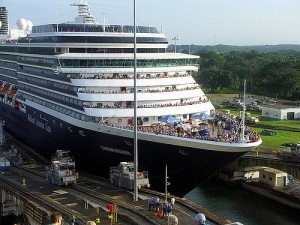
(Physorg.com) Expanded sections of the Panama Canal are due to open in 2014 following an eight-year programme to widen and deepen the waterway in order to increase capacity for liner shipping.
This will remove the breadth restriction of 32.2m (known as ‘panamax’ in the shipping industry) that has constrained ships using the canal since it opened in 1914.
The main reason for the expansion is to increase the capacity of the canal by facilitating the passage of larger container ships, to the benefit of the Panamanian economy for which canal revenues make a significant contribution.
But in a paper published this month in the International Journal of Maritime Engineering, Paul Stott and Dr Peter Wright of Newcastle University, UK, argue this $6 billion programme offers the industry as a whole an opportunity to reduce its environmental impact.
“This is a great example of unintended consequences,” explains Mr Stott, a senior lecturer in marine engineering at Newcastle University.
“Potentially, what we have here is an ideal opportunity to implement some quite simple changes that will make a significant difference to the environmental credentials of the industry.”
In the study the Newcastle team have quantified significant potential gains in efficiency in the dry bulk trades – that is the shipping of grain, ore, coal and so on – which result directly from the expansion of the canal.
“The relaxation of the constraint will have two main effects,” explains Mr Stott, a senior lecturer in marine engineering at Newcastle University.
“Firstly, it will permit more efficient hull design and secondly it will permit larger bulk carriers to trade through the canal with the associated economy of scale.”
The research presents analysis of bulk shipping developments that strongly support the contention that there is a demand for vessels in the dry bulk panamax sector that are larger than the current 85,000 tonne limit imposed by the beam constraint.
Mr Stott explains: “The potential savings in fuel costs are substantial, as is the consequent reduction in emissions, potentially saving up to 16% per tonne-mile.
“This is important given that the International Maritime Organisation estimates that shipping was responsible for about 2.7% of global emissions of CO2 in 2007 but warns that this may rise to between 12% and 18% by 2050 if the shipping industry does not take major steps to reduce emissions.
“Currently, much research into carbon reduction is focused on fairly radical ideas but good, solid engineering, hull design and optimisation in particular, still has a major role to play in achieving the goal of reducing emissions.”
The panamax constraint is routinely applied far wider than in just the liner and bulk carrier trades.
Around 45% of all vessels over 20,000 gross tons delivered over the past decade have had panamax beam and there are currently over 1,500 such vessels on order for future delivery despite the impending demise of the beam constraint.
Newcastle University is recognised as a major centre for research into sustainable science and technology, focussing its research towards finding solutions to this global problem.
Mr Stott said work was now ongoing to identify the extent of the potential ‘windfall’ in all sectors of the fleet.
“Alternative fuels and new technologies will be vital for driving the marine industry forward to a more sustainable future but this is a change we can make now through the application of existing technologies that are well proven,” he explains.
“Increasing beam is not a possibility for retro-fit and the benefits in the immediate future may therefore be limited by the young age of the merchant fleet.
“We have probably established the panamax fleet for the next twenty years in the shipbuilding boom of the last five years.
“Having said this, there remains a significant orderbook of new ships that could potentially benefit from re-design with increased beam and possibly increased capacity with consequent gains in efficiency for the owners and benefits for the planet.”
Provided by Newcastle University